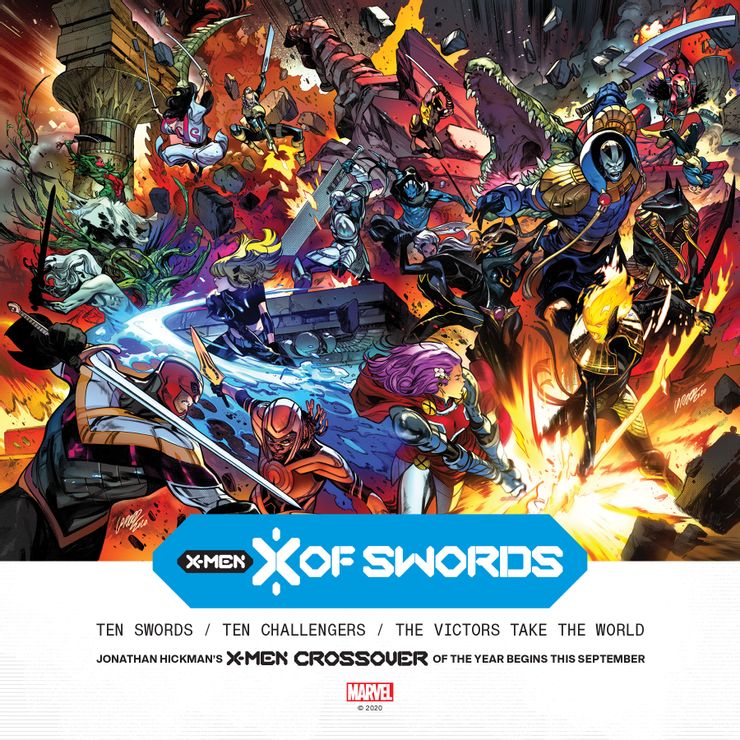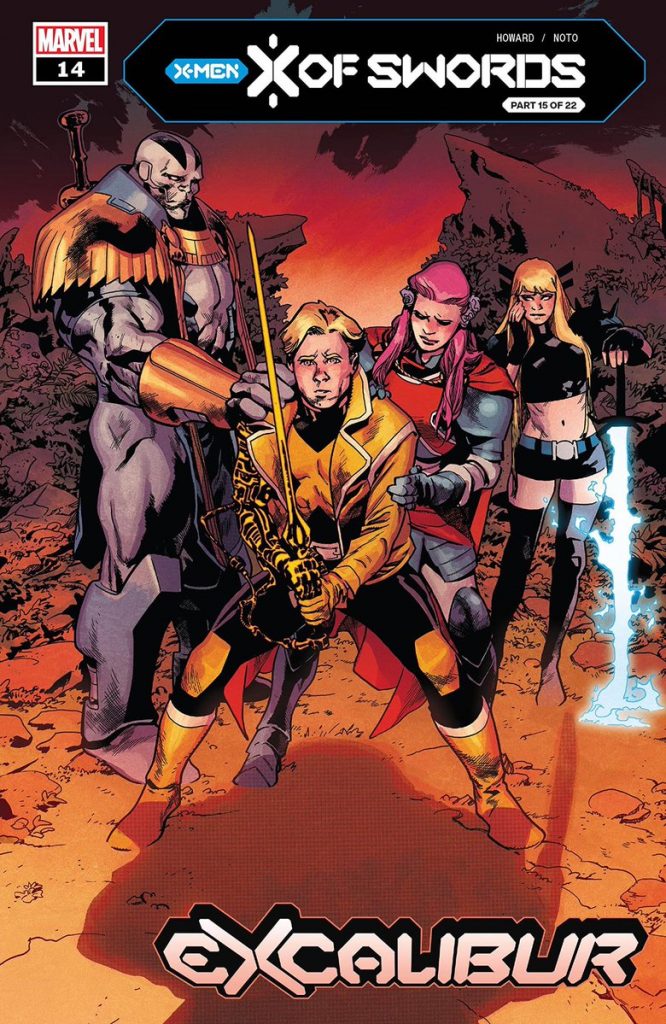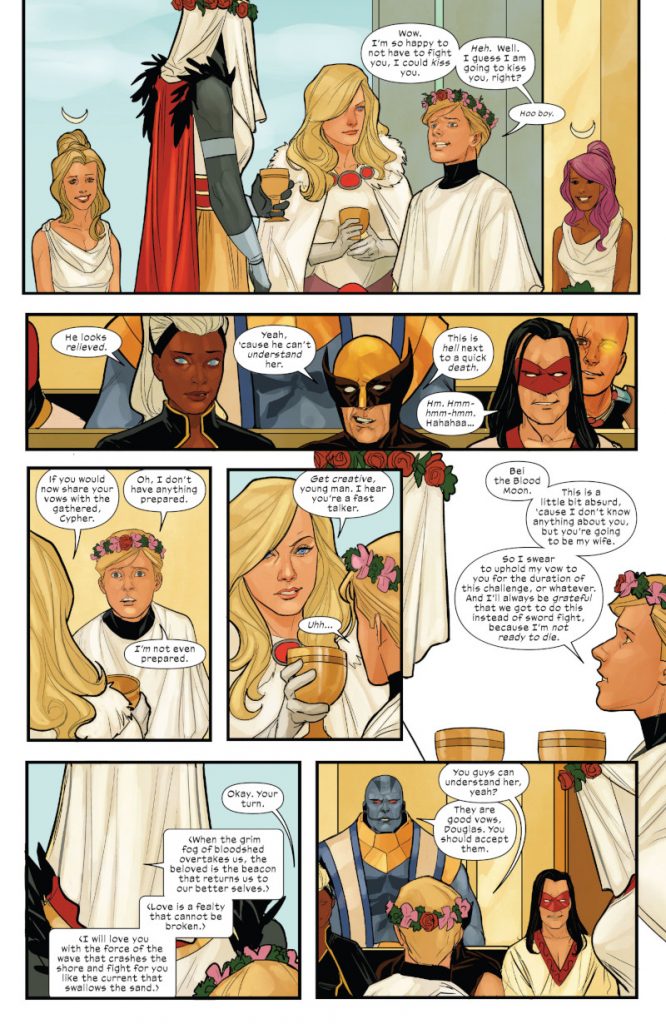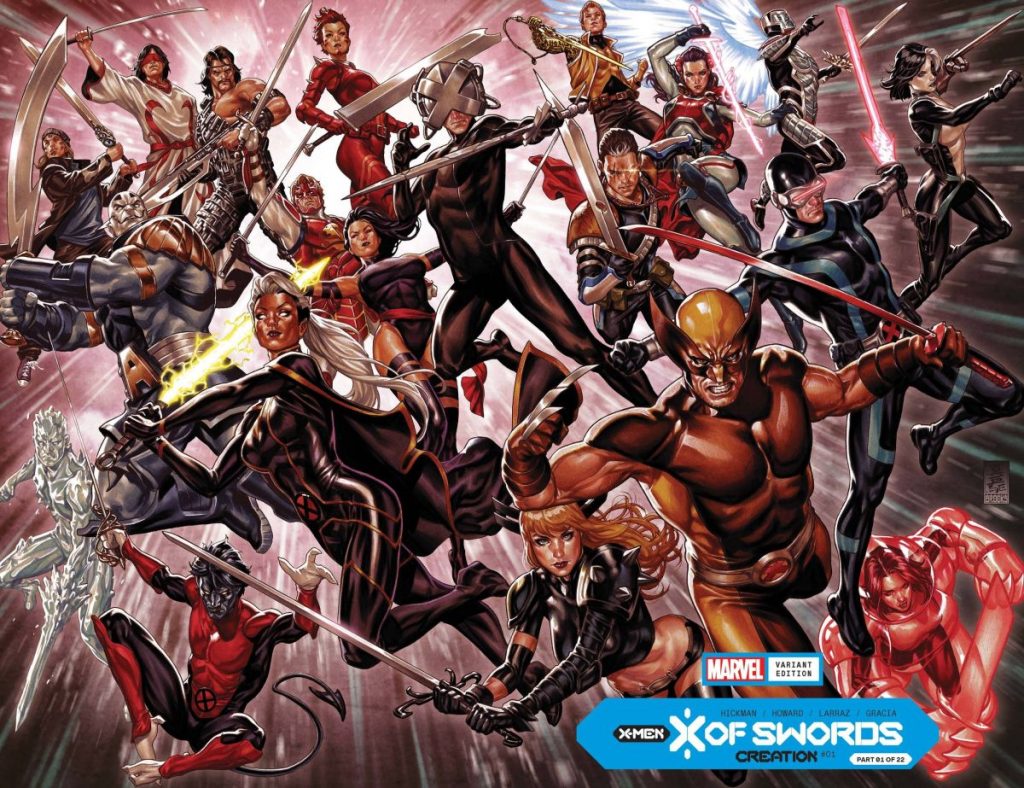“X of Swords” and the Battle Against Expectations
"X of Swords" isn't the story many thought it would be. It’s better for it.
Event comics are curious things.
Given the past few decades they’ve been a core element of superhero storytelling, beginning with Marvel’s first Secret Wars in 1984, we’ve all come to expect a certain cadence and structure to each of them. The set up. The conflict. The twist. The conclusion. All battles and iconic images and nothing will ever be the same, these immense crossovers and the shapes they take come with attached expectations of what they could – or should – be.
That’s part of the reason readers love them, I’d wager. There’s comfort within events, even if it’s couched in dramatic uncertainty. You know what you’re going to get, despite each being described as earth-shattering, senses-altering, universe-shifting mega-stories. Because of that, crafting an event is probably not unlike driving a time trial a second time in Mario Kart, except the creative team is always racing against a ghost version of their driver that they never, ever were. You’re always squaring off against expectations of performance, of what was and maybe should be again in the eyes of readers.
That puts something like “X of Swords,” the first crossover of the Jonathan Hickman era of the X-Men, and the creators behind it in an interesting position. Do you play the game the way history suggests you should, or do you roll out the crossover that matches the ethos of the line you’ve built, expectations be damned?
It’s fascinating because in the buildup, we all 1 bought into the idea that it would be the former, with many believing this story would prove to match its appearance on the surface: a sword fight between ten champions from two opposing lands, regardless of any prior expertise. 2 And yet, with Hickman at the helm – alongside co-architect Tini Howard – the answer should have been obvious the whole time. It was always destined to be the latter, as the X-Line went with the “you do you, no matter what people might think” route.
Predictably, the response has been polarizing to say the least. Some love it! Some hate it! Some are utterly confounded by it and feel little towards it! There’s a different flavor here for everyone, something for anybody if what you’re looking for is opinions about comics. The interesting thing for me, though, is I was deeply skeptical as it moved through the early chapters. In my head, I wondered about how this fit and that worked and so on and so forth. I ping ponged back and forth, trying to grasp what the teams behind it were trying to do.
That is until this past week, when a trio of issues made me – not unlike Dr. Strangelove – learn to stop worrying and love the Swords. 3 But I’m not everyone, and “X of Swords,” for better or worse, is its own thing. That makes it a perfect encapsulation of the true conflict at the center of every heavily bandied about story: expectations vs. reality, and whether your version of the former allows you to accept the latter, even if that chasm is often greater than the one between Krakoa and Arakko themselves. Whether it’s “good” or “bad” is almost immaterial. “X of Swords” faces something far more complicated than any qualitative questions, and that’s trying to bridge the gap between “what it is” and “what it isn’t” in the minds of readers.
Before we talk about what X of Swords is, I wanted to begin with what it isn’t and why that might be the case. That’s where much of the consternation with this event seems lie, as it lacks the hallmarks of many crossovers from the past and even the looks of what much of the buildup to this story suggested it could be. Consider this key art from artist Pepe Larraz that debuted in the lead up to the event’s launch in late September.

Awesome, right? That looks like a lot of fun, and more importantly, it also looks like what many people thought “X of Swords” would be: a big ol’ fight between a whole bunch of people who have swords. Positioned as a clash between the ten respective champions of sister lands Krakoa and Arakko – two islands that are one, if you will – the idea that these swords would be crucial to the narrative while also being used for fighting purposes was heavy on the minds of those who were excited about this series. There was even a whole lot of speculation about specific deaths, namely poor Doug Ramsey, who seemed to be the most likely to meet his demise during this event as a) he’s not exactly known for his fighting ability and b) he wasn’t on the cover of Vita Ayala and Rod Reis’ New Mutants #14, the first issue for the book in the post-Swords era, but his literal right hand man Warlock was. 4
People thought they knew what “Swords” was, largely because Marvel suggested in the buildup – at least visually – that this was what it would be. But the story has proven to be very light on the swords indeed, with six battles taking place so far and only three of them even featuring swords. 5 The interesting thing about this, though, is that none of it has contradicted what was said in the preamble of the series. I went back and reread much of Marvel’s officially sanctioned messaging and all the solicits, and almost everything is specifically, hilariously vague – almost as if they didn’t want people to know what to expect – while also matching what this story has proven to be. Take the official synopsis 6 that came with Larraz’s art, for example.
“The dark history of Arakko will soon be revealed, and when it is, the very future of mutantkind will be at stake…The victories will be legendary, the losses will be heartbreaking, and the revelations will send shockwaves throughout the Marvel Universe. This sprawling saga will have a lasting impact on the future of the X-Men, forever changing the fate of the franchise’s most prominent characters.”
16 chapters in, that synopsis lines up, even if it doesn’t match the art to go along with it. And we honestly shouldn’t be surprised by its failure to live up to the expectations many had for it from a plotting standpoint, if only because of what those at the top of the X-Line had to say about their objectives for these stories from the start. Consider this quote from Hickman himself when I asked him about one of the rules of the X-Office – which is “be additive, not destructive” – on Off Panel.
“I’ve said this in the writers room, ‘You need to stop telling those stories about killing characters. I understand that sometimes narratively you want to do something dramatic. But let me tell you as a storytelling mechanism, walking in the room and kicking all the toys over, it’s not a good look anymore. It’s not the kind of stories that people are willing to read, and it’s not actually helpful in terms of you doing your job five years down the road. It makes all of our jobs incredibly difficult.’”
…”You can’t play it as, ‘Oh my God, this is awful and terrible.’ You have to be more creative than that. And I’ve challenged all of the X writers. ‘It’s fine if you have a story where a character has to die, that’s fine. But what’s the other story? What’s the more interesting story?’”
Does that sound like someone who would be thrilled to launch an event that was the X-Men equivalent of Beatrix Kiddo versus the Crazy 88? Probably not. When you read the quote, it starts to add up that this event was never destined to be what Larraz depicted in that piece – at least not in totality – but that other story. The more interesting one. The one that sets something up only to knock it on its head. A story of single combat to the death hardly fits the philosophy of the line, with what it is in reality proving to be much more its speed. 7
The other thing it ended up not being, of course, was a 15-chapter story like it was originally announced as. After the direct market was on pause when Diamond closed for a time, “X of Swords” evolved into a 22-part beast, and one that even concerned me with its size. Why expand it by half again, or even more if you count the two prologue stories? Especially in a time where money is fairly tight given the pandemic and corresponding economic crisis? Jordan D. White had an answer for that in an interview with Newsarama.
“I think we were looking at the world around us and things were really looking down…but we saw all this and said ‘Let’s do something bigger and make a bigger splash! The world is bad right now. Let’s give people somewhere else to be for a while.’”
Now, I’m sure plenty of you read that quote and think, “Wow, what a cop-out when the answer is almost certainly ‘Marvel wanted to make more money from arguably its hottest line during a tough time.’” That’s a legit response, and I have no doubt that the additional revenue aspect of it played some part in the X-Office’s decision-making calculus. It may have even been the dominant reason.
But if the question is, “Do I buy White’s suggestion as to what the teams behind ‘X of Swords’ decided when they were expanding it further?” then my answer is yes. Reading it now, you can see that thinking reflected on the page, with its expansion leading to real gains. As much as the cynical answer likely jives with reality, the practical one of “the thing he said actually fits what ‘X of Swords’ is” works too. 8
So, if we’ve established what “X of Swords” isn’t and why it isn’t that, what is this 22-part crossover then? It’s a zany 9 world-building fest that expands the line’s dramatis personae while giving us a bigger, more interconnected sandbox that’s mostly free from the rigors of traditional Marvel antics. While we’ll get into the rest of those attributes here in a second, I wanted to talk about that last idea first.

As I was reading the early chapters of the story, part of me grated at the data pages. As much as I love them traditionally, the bulk of these pages being breakdowns for each and every section of Otherworld felt like a waste. Did I really need to know the inner workings of this whole world, from leadership to the story behind each? What do I care if there’s some mysterious group governing one of them now or that Roma and Merlin are now in opposition?
But then it dawned on me that I was thinking too small. 10 All of this wasn’t set up for “X of Swords;” it was for what came next, as Otherworld gives everyone in the X-Office a landscape to play with that lacks the rules and responsibilities of other parts of the Marvel Universe. Post “X of Swords,” the world of mutants will get a little bigger, as they expand to space and Otherworld at the same time, providing new, exciting storytelling opportunities for everyone.
That type of expansion offers freedom, and, as we’ve seen within “X of Swords” itself, the opportunity for a whole lot of fun as well. I’d put Hellions #6 and Excalibur #14 towards the top of the most entertaining issues of this era of X-Men so far, and it’s entirely because of the narrative opportunities this world opens up. Sure, it’s not a sword fight – yet! there’s still a long way to go! 11 – but what it has proven to be is something entirely unexpected. And it’s a blast to read because of it.
Take this past week’s trio of issues as an example of what this whole thing is actually about. Marauders #15 gave us a nearly deadly dinner party that expands relationships, improves our understanding of who these new characters are, and showcases what they’re capable of at the same time, all while being fun as heck. It even delivered a data page that was just betting odds on survival, an all-timer execution of the idea. 12
Over in the aforementioned Excalibur #14, those odds were flipped on its head, as the contest began and proved very quickly that what we’re going to get from each battle isn’t what we had expected. Remember Doug Ramsey, the guy I mentioned earlier who everyone thought would die, even down to his betting odds for survival being by far the worst on the table? 13 Well, he was given the most significant challenge of all: an arranged marriage. 14 Even more perfect? This character, whose mutant power allows him to understand all language, was forced to marry Bei the Blood Moon, an Arakki warrior whose power allows her to be understood inherently by everyone. 15 But for reasons not yet revealed, Doug cannot understand her at all. It’s beautiful asymmetry.

I hate to do this to another very solid issue in Wolverine #7, as it furthered the unconventional nature of this story with arm-wrestling, Wolverine getting drunk and then fighting people, 16 and Saturnyne playing court jester and queen at the same time, 17 but I want to focus on that Excalibur issue here. I believe it’s at the core of what makes “X of Swords” not just good, but remarkable in its own way.
While not every story beat hit – the Jubilee/Shogo part felt like plot requirements more than a natural extension of the story – what Tini Howard and the honestly astonishing performance from Phil Noto did was lay the true objective of this crossover bare to the world. We all 18 expected death – and it may still come – when Doug and Bei were paired up. But instead, we were given a new, wildly unexpected opportunity and a fascinating bridge for the future. Now, a champion of Arakko and Amenth, Bei the Blood Moon, and a mutant champion who doubles as Krakoa’s voice, Doug, have been united. This sets up all kinds of interesting connections for the future, even beyond its position as an unbelievably charming twist.
This is the definition of being additive, not destructive, and that central rule of the X-Office might be what this whole story is truly all about. What if the story some thought this was going to be – ten combatants from two sides fighting to the death – was actually misdirection for something far more extraordinary: a 22-chapter run that unites and expands the X-Line in a new way altogether?
I mean, just think about it. What’s the point of introducing the expanded architecture of Otherworld and all of these new characters if you’re just going to kill them and peace out forever? 19 We’re invested in these characters now – well, at least I am – and seeing the relationships they’re forming with the Krakoans as a beginning rather than a respite before their doom is far more interesting to me. 20
I’ve been reading comics for three decades now, and you get to know the rhythms of these stories pretty well. As noted earlier, there’s comfort in that. But you know what I found myself doing as I read those three issues from the past week? Smiling, because whatever was going to come next was unlikely to be what I expected. It could be a sword fight or a wedding, arm wrestling or a drinking contest, or anything in-between. Everything was on the table, because business as usual was off it. And that was a genuine thrill.
Naturally, I’m going to do my usual fence-sitting routine here by saying if you don’t like “X of Swords,” that’s completely fair. I will readily admit that it’s uneven and that it took until this past week of releases for it all to snap into place for me. So if your hesitance is qualitatively-based, I get it. But if you told me that it doesn’t work simply because it fails to live up to what you thought this story would be, the question I’ll ask of you is this: do you really want stories to just be what you expect?
The thing I love about the Hickman Era for the X-Men is it’s the first time in forever where I never know what to expect from the line. It isn’t big fight, character drama, event, death, rinse, repeat. It’s finding that other story, that more interesting story, and then figuring out how to execute that. Does it result in universally great comics? No. But I will say this: its dedication to finding new answers to old questions has me wanting to jump back onboard with every title at the end of this, and that’s something I genuinely didn’t see coming from “X of Swords.”
That it didn’t match the marketing buildup doesn’t take away from its successes as a story, especially considering by all accounts, “X of Swords’” shot was called long ago. If we read the room rather than the hype machine, we likely would have known that this story was never going to be what we expected, because what we believed it might be didn’t match the objectives of this new era. So, going back to it, if expectations fail to match reality, does that make it any less of a story?

I’m not sure. Your answer likely depends on what you think of this crossover. And hey, my story may change here in a bit if Bei the Blood Moon 21 bathes in Doug’s blood and Death kills everyone else by taking off his mask and staring at them, which honestly seems like a bit of a cheat code in a fighting competition. That could happen!
After all, events are naturally stories of convention, with an expected formula to be followed and accepted markers for what makes them important. 22 That’s the way they work, and this one may as well in the end. Subverting those expectations and removing the parameters of what a crossover is supposed to be shouldn’t be such a radical idea, and yet here we are. But I realized something when I was reading this past week’s trio of releases, and that’s how much I love to be surprised by superhero comics. “X of Swords” certainly does that. While it may result in an ultimately minor entry in the annals of X-Events, you know what it does do? It brings joy to me with each and every unconventional choice the team has made in building this wild, unexpected, and honestly delightful story.
And in a year that is a century and a time that’s endlessly scary and exhausting, I’ll take what it ended up being over what it appeared it might be any day of the week.
Seemingly, at least.↩
Sorry Doug!↩
Let it be known that I really, really wanted to make an analogy in this paragraph to Slim Pickens riding the bomb in Dr. Strangelove but unfortunately my quota of Kubrickian references was already met in the same paragraph.↩
Hmmm…I wonder if they planned it that way?!↩
And two actually were internal battles between two Krakoans and two Arakki, so even the nature of the conflict isn’t what it seems, although “battle” might be generous for the former.↩
With the bulk of marketing hype removed.↩
More on this later.↩
Full spoiler warning going forward, by the way.↩
Once you have a giant lizard man named Pogg Ur-Pogg and a sassy demon mutant arm wrestle, you qualify as zany.↩
It took me a bit but I got there eventually!↩
I’d wager heavily against it ever becoming what Larraz’s key art suggested it might be, though.↩
True story, though: I initially thought that was the checklist at the end of the issue and briefly stopped reading. Wah wah wah.↩
5,000 to 1 when the next worst odds are 100 to 1? My god, the house is going to lose everything on that line because every halfway intelligent bettor in Otherworld plopped at least a small sum on that. Give me a comic about that story, Marvel!↩
Marriage, the true battleground, am I right? (I am not right. Marriage is great.)↩
She doesn’t speak in a traditional sense as much as she psychically wills her message towards people.↩
Okay perhaps not entirely unconventional.↩
Saturnyne is almost certainly the true big bad of this story, as they’re turning her into a real Loki type for the X-Men.↩
And when I say all, I mean everyone from the readers to the characters themselves, as everyone from Krakoa was floored by how quickly Doug was swept away, utterly believing this could be the last time they would see him.↩
Watch everyone die this week in sword fights, including Doug.↩
There is seriously no sword fight starring Doug Ramsey that I would have been more invested in than the unexpected twist we were given in Excalibur. We’ve seen Doug die before. But this? Definitely not!↩
We really should have seen her role coming given that her name is literally pronounced “Bae.”↩
Typically characters dying, in my experience.↩
